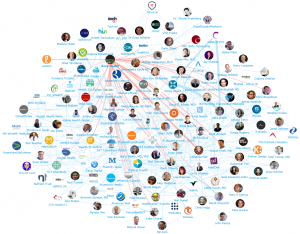 This cool network map is brought to us by Onalytica, which is in the business of identifying online social network digerati — the Who’s Who of social/digital influential people across a whole range of industries.
This cool network map is brought to us by Onalytica, which is in the business of identifying online social network digerati — the Who’s Who of social/digital influential people across a whole range of industries.
Because you’re reading Health Populi, I’m showing you their latest map of digital health influencers (which includes, humbly, me pictured around 5 o’clock on the map in the lower southeast corner). I’m number 15 with an influence score of 9.32. This pales in comparison to the top influencer, the wonderful Dr. Bertalan Mesko, MD, PhD, the medical futurist based in Hungary. @Berci is his Twitter handle, and he scores 100 — indexing the rest of us who fall in his digital shadow.
The Onalytica team used their Influencer Relationship Manager software to generate the list of the Top 100 Digital Health Influencers, shown in the map. There are 50 individuals and 50 companies. The top 10 digital influencing companies among the 50 are StartUp Health, Rock Health, Nuffield Trust (UK), HIT Consultant Media, HIMSS, MedCity News, Digital Health, DigiHealth Helper, Validic, and Omada Health.
 Here was the methodology: Onalytica examined 90 days of tweets, 208,627 of them generated by 29,527 engaged users yielding 113,447 “engaged tweets.”
Here was the methodology: Onalytica examined 90 days of tweets, 208,627 of them generated by 29,527 engaged users yielding 113,447 “engaged tweets.”
The top ten topics covered by this group included data (25%), Internet of Things (18%), wearable tech (16%), apps (9%), cancer (8%), artificial intelligence (7%), cybersecurity (6%), telemedicine (5%), genome (3%), and fitness (3%).
Health Populi’s Hot Points: I’ve just returned to the office from attending the MM&M Transforming Healthcare 2016 conference in New York City, sponsored by Haymarket Media and Medical Marketing & Media magazine. What’s so clear coming out of the full day’s agenda is that “digital” is now embedded in health and health care. It is normal, even expected behavior for a patient to Google symptoms before seeing a doctor, or shortly after seeing a clinician who delivers a diagnosis. Most clinical trials involve online patient recruitment, and the entire pharma industry is now fixated on the concept of the “value beyond the pill” — largely focused on digitally-enhanced therapeutics, where digital tools, services and delivery mechanisms can turbocharge the impact of a drug or therapeutic intervention.
It’s important to see (if you squint your eyes), the make-up of the individuals who influence digital health in the community map. There are patients and patient advocates. There are doctors like @Berci: Dr. Robert Wachter, Dr. Leslie Saxon, Dr. Greg Weidner, Dr. Kevin Pho, and Dr. Brennan Spiegel. There are health IT developers and venture capitalists, incubators for start-ups, digital health companies, health care providers (new-new models like Omada Health), health IT vendors, associations and government agencies.
The digital health village is maturing and growing to include the entire ecosystem of stakeholders, expanding in number and depth year over year. I’ve been part of this community since health groups first appeared on America Online, CompuServe and Prodigy. I had accounts with all three of these services, and paid dearly for each subscription at the time. My first health care interaction online was in 1996 when I asked Dr. Alan Greene, famed online pediatrician who had a presence on Prodigy at the time, a question about a rash on my (then) new baby daughter’s scalp.
That daughter is now a rising junior in college studying, of all things, digital and interactive design. She’s got long, lush hair and her scalp is healthy. Thank you Dr. Greene! And note that Dr. Greene continues to be a digital health pioneer, currently serving as Chief Medical Office to uBiome and continuing his pediatric practice.
It’s sure wonderful to be part of this ever-growing tribe.
You can review the tweets generated at the MM&M conference using the hashtag #MMMTransformHC.





 I was invited to be a Judge for the upcoming
I was invited to be a Judge for the upcoming  Thank you Team Roche for inviting me to brainstorm patients as health citizens, consumers, payers, and voters
Thank you Team Roche for inviting me to brainstorm patients as health citizens, consumers, payers, and voters  For the past 15 years,
For the past 15 years,